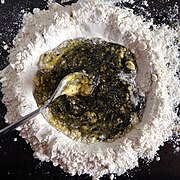Cephalopod ink
adding images to it so that it can be better illustrated. (December 2022) |

Cephalopod ink is a dark-coloured or luminous
The ink is released from the
A number of other aquatic molluscs have similar responses to attack, including the
Types of ink shapes
The shapes taken by ink releases are classified as six types:[3]
- pseudomorphs;
- pseudomorph series;
- ink ropes;
- clouds/smokescreens;
- diffuse puffs;
- mantle fills.
Inking behaviours
I was much interested, on several occasions, by watching the habits of an Octopus or cuttle-fish ... they darted tail first, with the rapidity of an arrow, from one side of the pool to the other, at the same instant discolouring the water with a dark chestnut-brown ink.
Escape strategies
Two distinct behaviors have been observed in inking cephalopods. The first is the release of large amounts of ink into the water by the cephalopod in order to create a dark, diffuse cloud (much like a smoke screen) that can obscure the predator's view, allowing the cephalopod to make a rapid retreat by jetting away.
The second response to a predator is to release pseudomorphs ("false bodies"), smaller clouds of ink with a greater mucus content, which allows them to hold their shape for longer. These are expelled slightly away from the cephalopod in question, which will often release several pseudomorphs and change colour (blanch) in conjunction with these releases. The pseudomorphs are roughly the same volume as and look similar to the cephalopod that released them, and many predators have been observed attacking them mistakenly, allowing the cephalopod to escape (this behaviour is often referred to as the "blanch-ink-jet manoeuvre"). Thus, such capture avoidance method is analogous to fighter jet dogfights where the followed pilot releases countermeasures (such as flares) to misdirect the sensors in some guided missiles. [citation needed]
Furthermore,
Hiding strategy
The
Behavior around eggs
Octopuses have also been observed squirting ink at
Numerous cuttlefish species add a coat of ink to their eggs, presumably to camouflage them from potential predators.[7]
Properties
Attack protection
Inking has been shown to protect species of squids against predatory fish attacks, as well during the capture phase as during the consummatory phase, due to visual and chemical effects of the ink releases.[8]
Chemical effects
Many cephalopod predators (for instance moray eels) have advanced chemosensory systems, and some anecdotal evidence[9] suggests that compounds (such as tyrosinase) found in cephalopod ink can irritate, numb or even deactivate such apparatus. Few controlled experiments have been conducted to substantiate this. Cephalopod ink is nonetheless generally thought to be more sophisticated than a simple "smoke screen"; the ink of a number of squid and cuttlefish has been shown to function as a conspecific chemical alarm.[6][10]
Physical properties
This section needs expansion with: examples of other inks besides that of the common cuttlefish, and comparisons between them. You can help by adding to it. (July 2018) |
Heteroteuthis dispar is a cephalopod species known for releasing luminous ink. The light comes from a substance produced by a dedicated organ before being transferred into the ink sac.[12]
Chemical composition
Cephalopod ink contains a number of chemicals in a variety of different concentrations, depending on the species. However, its main constituents are melanin and mucus.[13] It can also contain, among others, tyrosinase, dopamine, and L-DOPA,[13][14] as well as small amounts of free amino acids, including taurine, aspartic acid, glutamic acid, alanine, and lysine.[6]
Use by humans

Cephalopod ink has, as its name suggests, been used in the past as

Modern use of cephalopod ink is generally limited to
Studies have shown that cephalopod ink is toxic to some
References
- ISBN 0-521-64583-2
- ISBN 978-0-632-06048-1.
- S2CID 84629175.
- S2CID 54223984.
- S2CID 225286704.
- ^ S2CID 9539618.
- ISBN 9789251053836.
- .
- ^ MacGinitie, G.E. and MacGinitie, N. (1968) Natural History of Marine Animals, pp. 395–397, 2nd ed. McGraw-Hill, New York.
- ISSN 0022-0981.
- PMID 27294674.
- .
- ^ PMID 24824020.
- PMID 29281314.
- ^ ISBN 978-4-431-67017-9.










